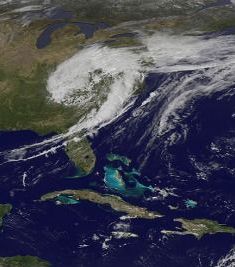Weather forecasting hit by funding cuts
 (NPR): Federal budget cuts are threatening to leave the US without some critical satellites, officials say, and that could mean less accurate warnings about events like tornadoes and blizzards. In particular, officials at the National Oceanic and Atmospheric Administration are concerned about satellites that orbit over the earth's poles rather than remaining over a fixed spot along the equator. These satellites are "the backbone" of any forecast beyond a couple of days, says Kathryn Sullivan, assistant secretary of commerce for environmental observation and prediction, and NOAA's deputy administrator.
(NPR): Federal budget cuts are threatening to leave the US without some critical satellites, officials say, and that could mean less accurate warnings about events like tornadoes and blizzards. In particular, officials at the National Oceanic and Atmospheric Administration are concerned about satellites that orbit over the earth's poles rather than remaining over a fixed spot along the equator. These satellites are "the backbone" of any forecast beyond a couple of days, says Kathryn Sullivan, assistant secretary of commerce for environmental observation and prediction, and NOAA's deputy administrator.
It was data from polar satellites that alerted forecasters to the risk of tornadoes in Alabama and Mississippi back in April, Sullivan says. "With the polar satellites currently in place we were able to give those communities five days' heads up," she says.
But that level of precision could diminish in the next few years, Sullivan says.
One important NOAA satellite in a polar orbit will reach the end of its expected life around 2016. And its replacement has been delayed by a continuing resolution passed by Congress that limits the agency's ability to pursue its new Joint Polar Satellite System. Sullivan says that means there could be more than a year when the nation is lacking a crucial eye in the sky.
Category: Science and Nature

